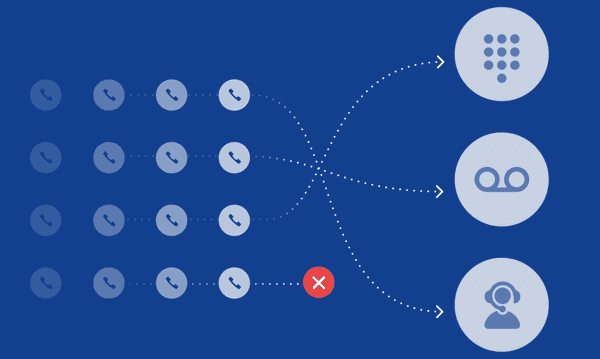The Best Way to Route Your Inbound Calls Efficiently and Deal with Spam
Like most phone owners, we are sure that you are familiar with numerous irritating calls imposing useless proposals or questionnaires. The costs associated with junk calls can be very high as they distract you or your employees from work. In this blog post, we will share with you how you can block unnecessary calls without losing customers, as well as how to build a clear system of forwarding incoming calls, as it allows you to distribute client traffic correctly.
7 min read

Elizaveta Komarova
Jul 15, 2021

Along with everyday calls, entrepreneurs and small business owners have to deal with a flow of advertising calls with telemarketers selling products and services that are not directly related to their business activities. Moreover, some believe that they need to be in touch 24/7 and will answer every inbound call. With this approach, the risk of burnout is very high, and as a result, business effectiveness can decrease dramatically. Besides, even if most of the calls are received by your employees, their experience is not always sufficient for high-quality inbound calls service in some complicated cases. All these issues can be easily solved with an effective inbound calls management system. Here are some tips to help you build an effective call management system of your own.
First of all, to manage incoming calls efficiently, it is necessary to:
- Build a reliable voicemail system. Often, entrepreneurs are afraid to miss customer calls as a missed call can mean a missed opportunity; consequently, they try to answer all inbound calls at any hour of the day, often, this can result in accidentally answering promotional calls. In order to avoid losing leads without wasting time on unwanted calls, you need to install a voicemail system that will be a reliable backup to handle calls when you are unavailable to answer. Not only will the voicemail take care of calls when you are out of hours, but it will also give you the freedom to prioritize callers while you’re at work.
- Separate business and personal calls by setting up a redirecting system. As some small businesses owners use the same number for personal and business calls, a redirecting system can ensure that every valuable call is answered. While a redirecting system is a quick fix, having a separate number for your business is important. It will help you to appear more professional, help with work-life balance and ensure that personal calls don’t impact business activities.
- Set a filtering system for incoming calls to get rid of junk calls. Typically spam and advertising calls are carried out either by bots or sales teams who are instructed to achieve their goals by all means. They have their own call tactics and strategies, so developing a clear algorithm for working with such calls without losing business efficiency is important.
Options You Need to Handle Inbound Calls

Cloud-based phone systems are a technology that comes inbuild with a wide range of features that make it easy to manage, filter, and distribute calls, such as call-forwarding, voicemail, call waiting, and call blocking.
Here is a breakdown of the most useful features to help you manage inbound calls.
Forwarding Voicemails to Your Email
Missed calls are unavoidable, you may be out of hours, or you may be caught up with other important tasks, in this case, the call goes to voicemail. Voicemail is one of the most important options of cloud PBX as it can help you to stop missing important messages. It does this by allowing the caller to leave a voice message after the phone rings out and then a mail sent to a specified email address. Therefore, even if the call was made during non-working hours or for some reason the clients did not reach the company, they will get the call back at a convenient time, and the call will not be lost.
For example, if you receive an incoming call and you are currently out of the office or busy, the caller hears a short, recorded greeting with a suggestion to leave a message. After the message is left in the voicemail box, the system will send an email notifying that there is a missed call. Forwarding calls to email allows you can prioritize your calls as you know who called you and why.
The key to using a voicemail efficiently is having a professional and friendly greeting, this ensures that despite the call not being answered by a person, the customer still feels as though the experience is of high quality. If you need more ideas for voicemail greetings, you can use Voicemail Greeting Generator, this can help to save you time while ensuring it is personal and professional. Depending on your personal preference, you can just choose a voice to vocalize your message, type in your own text, or select one of the proposed presets, download an mp3 file and start using it.
Redirection of Inbound Calls
Call transfer is a feature that forwards incoming calls to another number. Call transfer has a number of different functionalities, not only can you transfer the conversation to a certain employee if you are absent, but you can transfer to a number of colleagues with more availability if you are busy. Thanks to the prescribed algorithms, calls can be distributed depending on the qualifications of the staff, on the time day, and the schedules of their shifts, as well as offering the ability to redirect customers to specialists they regularly speak with. Alternatively, you are able to get important business calls forwarded to your number without losing valued clients or partners, this significantly improves the quality of service, which in turn increases customer loyalty.
Call forwarding also offers the option to easily separate personal and business calls by transferring specific callers to your personal or home number. Most cloud-based PBX systems allow you to use multiple lines on one phone; therefore, you can have a separate number for business calls without the need to buy any additional equipment or use a second cell phone. The major benefits of this are that you don’t need to give your personal number to clients and colleagues anymore, you no longer miss valuable business calls, and you can easily maintain your work-family balance.
Creating Black and White Lists
A blacklist is a list of numbers of unwanted or spam callers and companies that are trying to sell their services or goods to you unannounced. When running a business, you can improve productivity by restricting junk calls and saving employees from answering these calls. For example, such callers can be immediately connected to “the called party is unreachable” announcement or a “busy signal”. Some of the Virtual PBX systems also provide an opportunity to create a set of rules, and when these rules are triggered, the unwanted caller’s number is automatically put on the blacklist, and its next calls will be blocked for a certain time.
On the other hand, the whitelist will prioritize receiving calls from certain customers, and callers from this list will not be blocked by any means. All other calls can be diverted to voicemail or forwarded to a certain specialist depending on your settings.
You can manually remove and add numbers to white or blacklists, and some systems allow the call center to add the callers to the blacklist directly during the conversation.

Filtering with IVR (Interactive Voice Response)
Some virtual phone systems provide an integration of different IVR scenarios, which is an interactive voice menu for fast processing of incoming calls. This technology allows you to automate the processing of incoming calls and quickly redirect calls by simply moving customers to the right sections of the menu without attracting employees.
IVR function helps you to work with customers personally and quickly transfer them to the right operators by choosing and pressing certain key buttons. For example, the client calls the company to find out the terms of delivery. IVR answers the call with a recorded voice message and offers to listen to the voice menu: “Press the number 3 if you want to learn more about delivery terms.” The client immediately gets the necessary information by clicking this button or clicks another button to speak with an operator. Moreover, modern IVR systems can recognize voice commands from callers, dramatically saving the customer time and increasing service quality.
IVR option not only reduces the operators’ workload, allowing them to deal with more complex tasks and issues but helps to increase the clients’ loyalty.
With all mentioned cloud-based PBX options, you can build a solid inbound call filtering and redirection system that allow you to focus on your crucial business activities rather than call center functions. And the more features and capabilities your company’s business phone system has, the more effective is the process of handling incoming calls.


